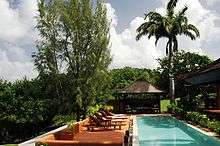Mustique
| Mustique | |
|---|---|
| Private Island | |
|
Location of Mustique | |
 Map showing the location of Mustique within the Grenadines | |
| Coordinates: 12°52′N 61°11′W / 12.867°N 61.183°WCoordinates: 12°52′N 61°11′W / 12.867°N 61.183°W | |
| Country | Saint Vincent and the Grenadines |
| Island chain | The Grenadines |
| Owner | The Mustique Company |
| European Discovery | 15th century by Spanish sailors |
| Area | |
| • Total | 2.2 sq mi (6 km2) |
| Population | |
| • Total | 500 |
| • Peak season | 1,300 |
| Website | Mustique Island |
Mustique /mʌˈstiːk/ is a small private island that is part of St Vincent and the Grenadines. The island is one of the Grenadines islands, most of which are part of St Vincent and the Grenadines, in the West Indies. The island is located within Grenadines Parish, an administrative area of the country.
The island covers 1,400 acres (5.7 km2; 2.2 sq mi) and it has several coral reefs. The land fauna includes tortoises, herons and many other species. Its year-round population of about 500 mostly live in the villages of Lovell, Britannia Bay, and Dover.
The island of Mustique is owned by the Mustique Company, which in turn is owned by the island's home owners. The island has approximately 100 private villas, many of which are rented out through the Mustique Company. In addition there is one hotel called the Cotton House, owned by the Mustique Company, and one privately owned seven-bedroom hotel called Firefly.
Early history
The history of the island of Mustique, and of the Grenadines in general, dates back to the 15th century, when Spanish sailors first sighted this more or less linear group of small rocky islands and named them "Los Pájaros" or "the birds", because they resembled a small flock of birds scattered across the sea in flight. During the 17th century the islands were renamed the Grenadines by pirates, who used the sheltered bays to hide their ships and treasure. The islands were later used by European planters to grow sugar cane. This lucrative industry lasted until the 19th century, when the extraction of sugar from European-grown sugar beet dramatically lessened the worldwide demand for tropical sugar.
Mustique's sugar plantations were abandoned and eventually swallowed up by scrub, leaving remnants such as the sugar mill at "Endeavor" and its "Cotton House". The Plantation House was built in the 18th century.
Later history
Mustique was purchased in 1958 by Colin Tennant, 3rd Baron Glenconner, under whose guidance the island began to be developed. In 1960, Princess Margaret, Countess of Snowdon, the sister of Queen Elizabeth II, accepted as a wedding present his gift of a 10-acre (40,000 m2) plot of land, where she built a residence called Les Jolies Eaux. In 1979, Mustique Island was transformed from a family estate into a private limited company with the homeowners as shareholders.
In 1971, the SS Antilles struck a reef not far off of the island, and sank.[1]
Residents and guests
There are a core set of names whose influence created Mustique for what it is today. In probable order, they are Colin Tennant, Oliver Messel, Princess Margaret, and Mick Jagger. Immediately prior to that the island was home only to a small number of poor fishermen and goats.[2]
Queen Elizabeth II, the head of state of St. Vincent and the Grenadines, and Prince Philip have made private visits to Mustique in 1966, 1977 and 1985.[3][4] Prince William, Duke of Cambridge, who is second-in-line to the Throne of St. Vincent and the Grenadines, and the Duchess of Cambridge vacation in Mustique often.[5][6]
David Bowie once owned an Indonesian-inspired multi-pavilion villa on the island, which he left asserting that "the house was so tranquil and peaceful that he found it hard to get any work done."[7][8]
In 1996, while on holiday at Mustique, Noel Gallagher wrote and demoed many of the songs that would later be released on Be Here Now.

Further reading
- Vaughan, Robert (1994). Mustique. Arne Hasselqvist & Alfred Publishing. ISBN 978-0-9640-2729-9.
References
- ↑ Middleton, Ned. "The Antilles, Malta". Simply Scuba. Archived from the original on 2012-09-04. Retrieved 2014-11-07.
- ↑
- ↑ Mark Johanson (23 January 2012). "Mustique Island: Kate Middleton's Caribbean Retreat". International Business Times.
- ↑ Wendy Leigh (7 September 2009). "He's the king of Mustique, the barman who knows the secrets of everyone from Winehouse to Jagger - but now he's going to tell all...". Mail Online.
- ↑ Rebecca English (5 February 2013). "Kate's off for a babymoon: Duke and Duchess jet off to £19,000-a-week Caribbean villa on final holiday before baby arrives". Mail Online.
- ↑ Tom Sykes (5 February 2013). "Kate Feels Well Enough to Fly ... To Mustique!". The Daily Beast.
- ↑ David Bowie
- ↑ "Inside David Bowie's holiday home". Retrieved 6 November 2016.
External links
| Look up mustique in Wiktionary, the free dictionary. |
